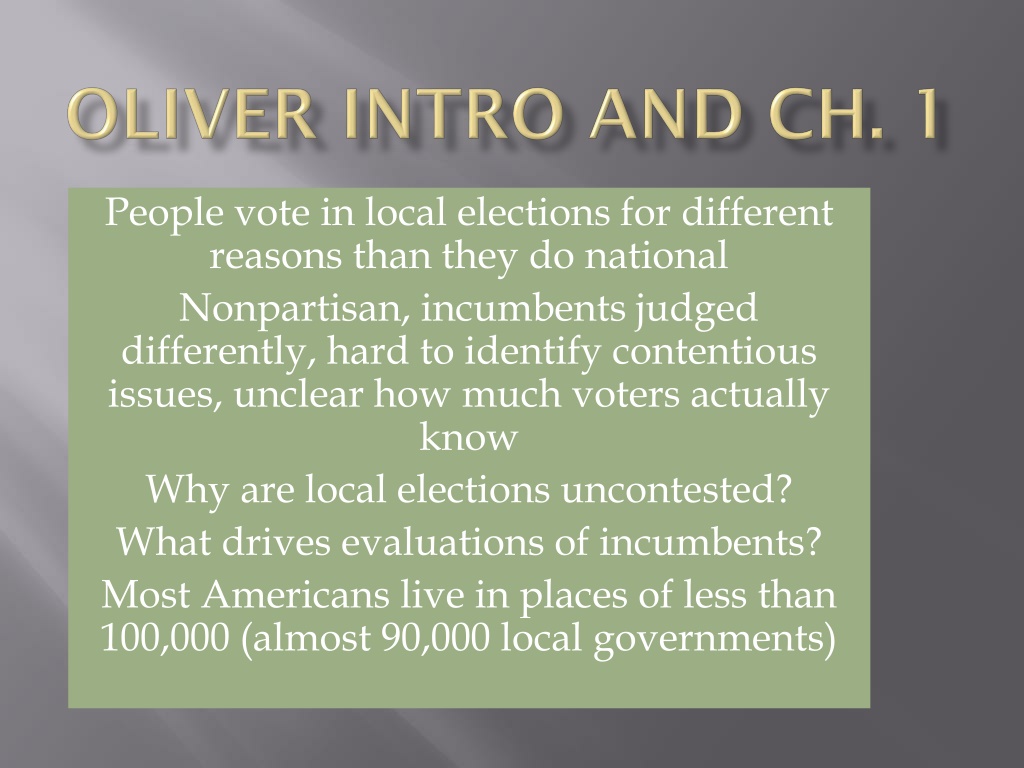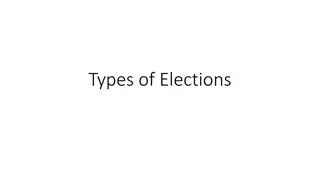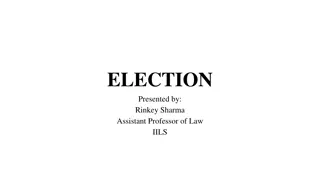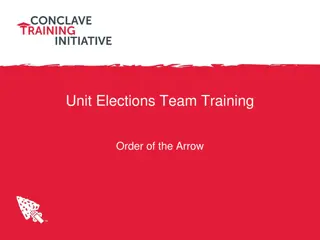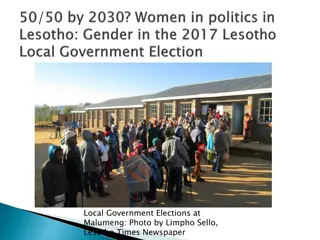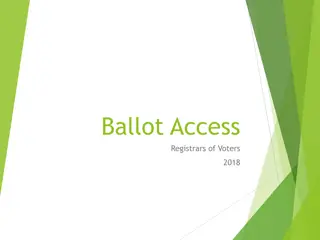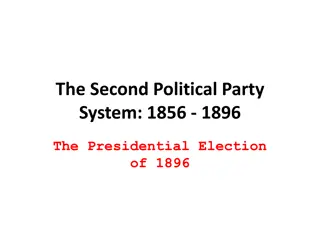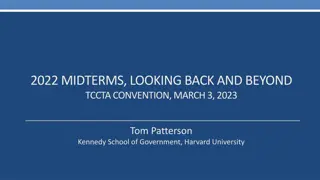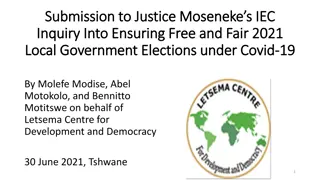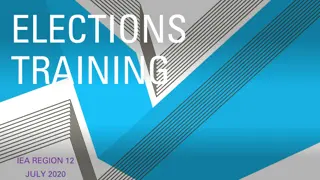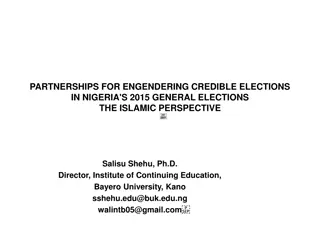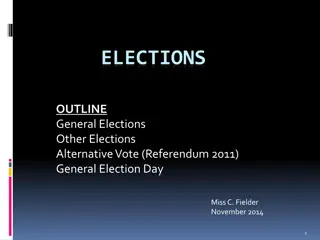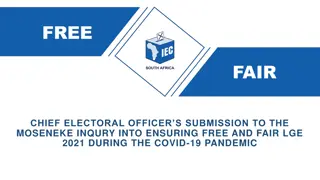Understanding the Dynamics of Local Elections in the United States
Local elections in the United States are driven by distinct factors compared to national elections. They often feature uncontested races and evaluations of incumbents shaped by custodial performance. Most Americans live in areas with less than 100,000 population, leading to unique characteristics such as informed and engaged local voters. Differences in size, scope, and bias differentiate local governments from national ones, influencing the nature of campaigns and governance.
Download Presentation

Please find below an Image/Link to download the presentation.
The content on the website is provided AS IS for your information and personal use only. It may not be sold, licensed, or shared on other websites without obtaining consent from the author. Download presentation by click this link. If you encounter any issues during the download, it is possible that the publisher has removed the file from their server.
E N D
Presentation Transcript
People vote in local elections for different reasons than they do national Nonpartisan, incumbents judged differently, hard to identify contentious issues, unclear how much voters actually know Why are local elections uncontested? What drives evaluations of incumbents? Most Americans live in places of less than 100,000 (almost 90,000 local governments)
What differentiates local governments from national? Size, scope, and bias Size: How many constituents they have Scope: How much power is in their offices? Bias: How evenly they distribute their resources among their members
Who runs for office? Ideological or civic- minded How are citizens mobilized to vote? Racial appeals, financial incentives, civic duty How voters decide: Issues, candidate charisma, partisanship, other factors Larger democracies are more likely to have more candidates seeking leadership Bias produces greater partisanship: groups divided in zero-sum game over resources
Unlike national elections, local elections involve a small number of voters deciding on offices with limited powers and undifferentiated stakes for an entire constituency (managerial rather than ideological characteristics in elections) Custodial performance of incumbents maintain balance between taxes and services Conflict tends to be over parochial and temporal issues
Local voters are much more likely to embody the classical notions of an informed and rational polis than are national voters. (p. 8) Most local voters are long-term residents and homeowners ( homevoters ) more likely to vote and better informed/more engaged, partisanship is less important Hard to predict issues that may decide elections may be seemingly trivial things
Distinctions of size, scope and bias are important larger places have more ambitious candidates and larger-scale mobilization efforts vs. knowing people personally in smaller towns Incumbents in towns that have more government services are more vulnerable than those with less Elections in poor communities tend to be more biased and more fiercely contested than wealthy
Property development and environmental concerns are important, but that doesn t mean that local politics is dominated by developers Local governments are not effective venues for addressing most deep socioeconomic cleavages Narrow scope and low bias of most local democracies inhibit pursuit of ideologically driven goals not a lot of discretionary resources or leeway for broader social agenda
Elections are not all the same local are usually nonpartisan, don t get much media attention, they don t give voters much public information, free of direct racial or ethnic appeals or preoccupation with crime or unemployment How to differentiate among tens of thousands of local governments in US? How do local elections differ from each other? How are municipal elections different from others? Size, scope and bias affect who votes, who runs, factors that shape vote choices Size: How big should a democracy be? Smaller societies make it easier to aggregate interests and give citizens access Larger societies can accomplish more: more services, grander projects, greater economies of scale
Most towns provide fewer services than larger cities (airports, ambulance, cemeteries, jails, election offices, fire stations, gas, health bureaus, hospitals, housing, police, library, nursing homes, parks, mass transit, sewage, waste, street repair, water) A larger democracy will be more powerful and more efficient than a smaller one Governmental accountability and access are lower in a large democracy than in a smaller one (ratification rather than deliberation)
Greater social heterogeneity of larger societies makes governing more difficult Smaller democracies are usually limited in the range of issues they need to adjudicate In larger societies, political processes are more rationalized, organized, and systematic
More organized political constituencies parties, interest groups; in smaller societies, aggregating preferences is much easier Residents of larger cities are less likely to vote than residents of smaller because they are less interested and less familiar with leaders Candidates in larger areas will be more ambitious and professionalized, campaigns more professionalized
As the size increases, personal connections become less important, group appeals and mass advertising become more important (civic associations, church groups, sports leagues) Which groups a candidate should contact depends on the scope and bias of the polity Larger democracies have wider range of issues, are more socially heterogeneous, have fewer personal interconnections among citizens Campaigns in larger democracies will center more on advertising, interest group mobilization, mass media, rather than personal contact; incentives for formation of organizations like parties and interest groups which are conduits to voters
Scope: Existential Versus Managerial Democracy Scope refers to a democracy s capacity for action and the extent to which it can exercise autonomous discretion over the population and institutions in its geographic area. Wealth and willingness of citizens to acquiesce to government actions Institutional determinants: Powers formally invested in the democracy (charter, constitution, other documents) Extent to which governing arrangements enable or inhibit decisive action on the part of its leaders Power sharing and consensus requirements restrict government s ability to pursue agendas
Nation-states have ultimate sovereignty; local government is, by definition, limited government Subunits of states, exist at discretion of state government; mostly deal with land usage and quality of life Summary of services provided by smaller municipalities; most are provided by counties or special districts; local services don t usually require redistribution or coercion
Smaller scope elections are less likely to be ideological and more likely to be managerial Ideological conflicts are likely to be parochial and temporal (quality of life, conflict among neighbors) Most small municipalities don t have a lot of discretionary spending Self-sorting: communities become homogeneous because people choose where to live and end up among people with the same priorities (good schools vs. lower taxes, etc.) less potential for conflict in less diverse places
Elections are decided on how well incumbents provide the services the community wants (property values, crime rates, test scores) Incumbents with more clearly defined responsibilities are more likely to be punished for economic downturns, on the local level it s about things like school closings Development vs. environmental preservation, idiosyncratic events may affect incumbent re- election
Bias: Extent to which costs and benefits are unevenly distributed among a democracy s constituents ( group costs ) Nearly every governmental decision will affect some citizens more than others; some citizens use services that others don t, some people may support a program they don t use themselves Bias: Types of policies that governments pursue, spending patterns, electoral arrangements (interest groups, gerrymandering, election types and schedules), affluence (poor democracies are more biased because of differential impact of decisions), ethnic and racial composition (distribution of resources, job, etc.)
Group activity is more important in biased systems, whether formal political organizations or loose networks, political cleavages are more visible Universalistic appeals vs. established interests will be more likely to emerge Dynamics of elections (who votes, who runs, nature of campaigns and vote choice) more predictable in biased democracies; in less biased democracies, incumbents will do well but issues are harder to predict
Larger democracies will have larger scope and are likely to be more biased because of heterogeneity States have more scope than local governments, but local vary among themselves Localities have the greatest variation in bias (chart, p. 48) Local governments that are small and low in bias most municipalities and many special district governments Small in size but high in bias independent school districts (a subset of the population gets a disproportionate share of the resources, groups play a large role)
How many constituents need to vote for a group to be truly democratic? Is the voting population representative of the population of the society as a whole? Homevoters in local elections low turnout protects property values and suppresses property taxes Who votes: how many, and the diversity of their sentiments (similar to polling techniques)
In a large, less diverse society, a low proportional turnout can provide an accurate measure of preferences if the voters are a randomly representative sample Who is most likely to vote? Intrinsically motivated, extrinsically mobilized, differentially affected by the costs of voting Intrinsically motivated: Those with the most financial, social, psychological stake in the outcome Greater benefits, identity tied to democracy s future ( stakeholders )
Candidates appeal to stakeholders and mobilize voters who are sympathetic to their views mobilization is extremely important Costs of voting information, time, number of steps to go through (knowing what to do, where to go) As a democracy narrows in scope, the population of stakeholders becomes increasingly small; as it becomes more biased, the variance in preferences among members becomes much greater Amount of bias in a democratic organization will skew material incentives toward voter turnout (US government is heavily biased in distribution of resources toward senior citizens); parents of school-age kids disproportionately vote in school board elections
Scope and bias affect the representativeness of a low turnout election those who benefit from a biased democracy are more likely to turn out, providing a less representative picture of overall constituent preferences Schedule of local elections (chart, p. 65) elections that don t coincide with national elections have far lower turnout Who votes in municipal elections is most determined by relationship to property (p. 71) Discussion of the importance of education in voting why are well-educated people more likely to vote?
Education is a more important predictor for renters than for homeowners, who vote in local elections regardless of their education level Homeowners are more likely to be contacted and mobilized, lower cost of voting (having to re-register when you move) Bias: Do homeowners and the well-educated have different preferences than renters and the less educated? Stakeholders have longer-established and more stable preferences Differences in preferences between homeowners and renters (renters are less likely to be taxed to pay for services, will be more likely to support generous social services)
